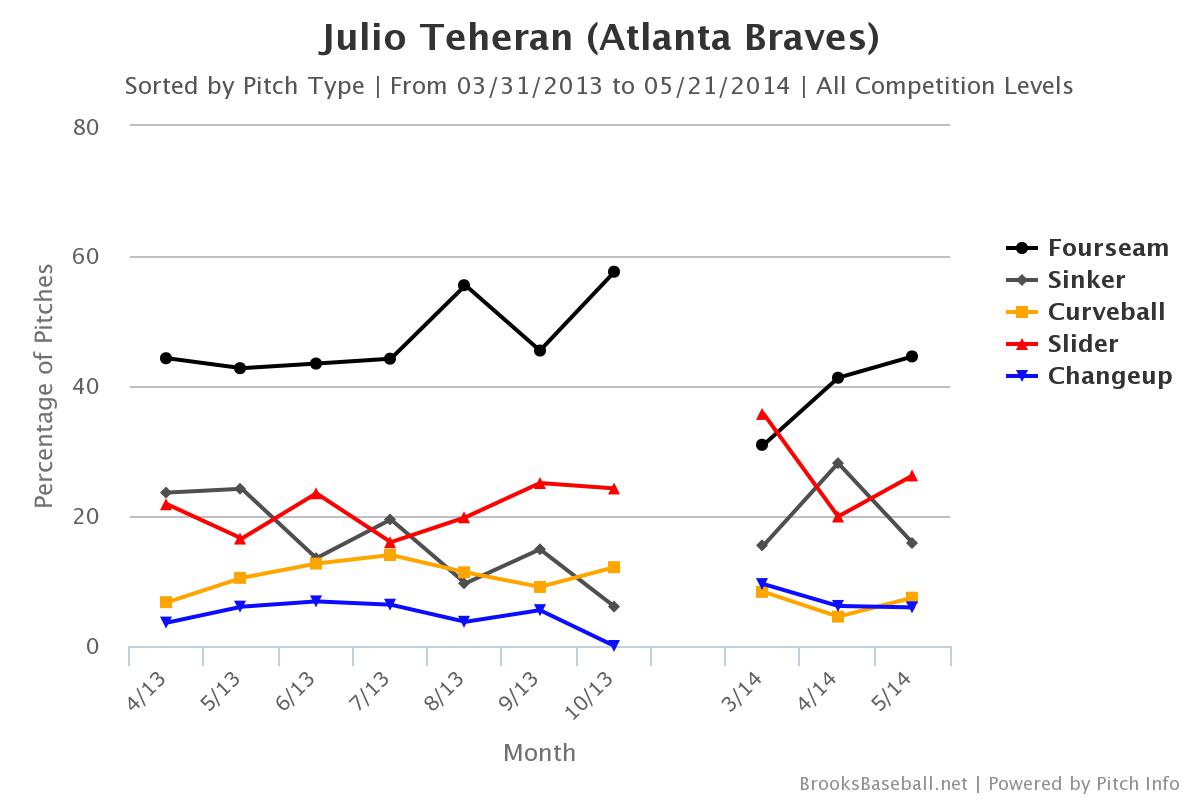2014 Fantasy Baseball: Julio Teheran Found His Groove

Julio Teheran, whom I’ve written about before, fired his second complete game shutout of the season Tuesday night. His first came against the Phillies; his second, against the Brewers. Julio Teheran is very, very good. But if you’re like me and look at peripherals a good deal, especially this early in the season, you might be a little worried.
Teheran’s ERA is microscopic, currently sitting at 1.92. His FIP, however, isn’t quite a sparkly, residing at 3.88. And his xFIP – which normalizes home run per fly-ball rates to 10% – sits at an even 4.00. So, why the discrepancy? A lack of strikeouts early on, for one.
Teheran didn’t miss many bats during his first four starts of the year. His strikeout totals were: 2, 6, 1, and 4. The start in which he struck out four batters was the aforementioned complete game shutout against Philadelphia. Over his next six starts though, Teheran began to look more like the 2013 version of himself, racking up strikeout after strikeout. Since April 21, Teheran has the following strikeout totals: 8, 5, 7, 9, 4, and 8. The last game, once again, is a complete game shutout.
For comparison’s sake:
| GS | IP | K% | BB% | HR/FB | ERA | FIP | xFIP | |
|---|---|---|---|---|---|---|---|---|
| March 31 – April 16 | 4 | 28.0 | 11.8% | 5.4% | 5.6% | 1.93 | 3.83 | 4.60 |
| April 21 – May 20 | 6 | 42.1 | 25.0% | 7.3% | 12.2% | 1.91 | 3.91 | 3.59 |
Quite the difference. His pitch usage has changed. In March, he threw his slider a ton, more than he’s ever thrown it in one month. In April, he used his sinker (two-seam) more than ever before. And finally, in May, so far, his pitch mix has looked more similar to the mix he leaned on down the stretch – September, specifically – last season when he was lights out. Check out his month-by-month pitch mix for this year and last:
[am4show have=’p3;p4;p7;p11;’ guest_error=’Front Office’ user_error=’Front Office’ ]
Teheran has always been a flyball pitcher. Because of that, he began utilizing a two-seam fastball in order to try and induce weaker contact. It’s worked somewhat – the pitch has a 37% GB rate this year (56% last year), while his four-seam fastball has a 30% rate. His two-seam offering, however, doesn’t generate many whiffs – 6% SwStr rate in ‘14 – but that is not its job, after all. So as Teheran has gradually increased his usage of his four-seam offering each month, he’s been generating more whiffs. The whiff rate on his four-seam fastball has been twice as good as the one on his two-seam offering, so far.
Teheran’s strikeout rate was always going to come back. His SwStr rate was good, even when the strikeouts weren’t piling up. It was only a matter of time before the strikeouts showed up.
And onto Teheran’s LOB% (left on-base percentage), which currently sits at 86.5% and probably isn’t sustainable over a full season. Teheran has shown the ability to strand hitters at an above league average rate. His LOB% last season was right at 80%, but a one year sample size isn’t ideal especially when the statistic can fluctuate extremely based on luck. It’s easy to scream: “Regression!” when examining this particular peripheral, but it isn’t that simple. Every pitcher is different. They arrive at their numbers completely different oftentimes.
| Situation | K% | BB% | K-BB% | FIP |
|---|---|---|---|---|
| Bases Empty | 16.5% | 8.0% | 8.5% | 4.36 |
| Men on Base | 25.5% | 4.1% | 21.4% | 3.12 |
| Men in Scoring | 29.1% | 3.6% | 25.5% | 3.08 |
Teheran, so far, has been at his best when he has needed to be. Thanks to the wonderful Baseball Savant, I was able to see what was different. Teheran, on average, throws his four-seam fastball ~1.4 mph harder with runners on base. Not a huge difference, but it’s there. Last year, there was only a .7 mph difference in such situations. My first thought was: “He’s probably conserving himself for the later innings.” But his inning by inning velocity doesn’t show that, so who knows? My thought at this point is that he just really reaches back for more when he really, really needs it. He wouldn’t be the first to do that; Hi, Verlander. And players, such as Carlos Beltran, have admitted they focus more during certain situations, so perhaps Teheran just has another gear? That could also be stupid speculation on my part. Moving on!
In theory, Teheran’s strikeout numbers with runners on should regress a little, towards his overall rate, but his numbers with the bases empty could also improve, according to his SwStr rate. After all, last year his strikeout rate with the bases empty was a little better than his rate with runners on (~1.2%). His performance with runners on so far, isn’t necessarily a harbinger of things to come, but it’s a fun little coincidence.
Lastly, while we’re talking about stranding runners, Teheran’s ability to pick off runners has without a doubt made a big difference. Last year, Teheran led the majors with eight pick-offs. He was the only right handed pitcher with more than three! So far, he’s only picked off one runner, but his pickoff move is a weapon that cannot be left out of this particular conversation.
Chances are, you’re not worried about Julio Teheran. But if you are, stop. His strikeouts are back. His walks are still down. His GB% has improved, if only ever so slightly. He’s been a little lucky on balls in play, but that should be expected when a pitcher has an ERA under two.
ZiPS projects Teheran to have a 3.57 ERA the rest of the way. I’m taking the under – maybe 3.30ish? Home runs, as usual, will be the challenge. Teheran’s flyball ways can get him into trouble, but when they stay in the yard he has a very good outfield defense – cough, Jason Heyward, cough – to run them down. His peripherals may not show it at the moment, but Julio Teheran is becoming a top-15 major league pitcher before our very eyes.
A few final notes: Since 2013, among pitchers who have thrown at least 200 innings, Teheran has the ninth best ERA. He has the eleventh best ERA+. He’s 23, and he’s already shown the ability to: scrap a pitch on the fly and switch to a more effective one (curve to slider), pitch deep into games (6+ innings, on average per start in 2013; 7+, on average in 2014), and really put his foot on the opposition’s throat when he needs to (25% strikeout rate during high leverage situations).
Columbian Jesus. Accept him into your heart.
[/am4show]






